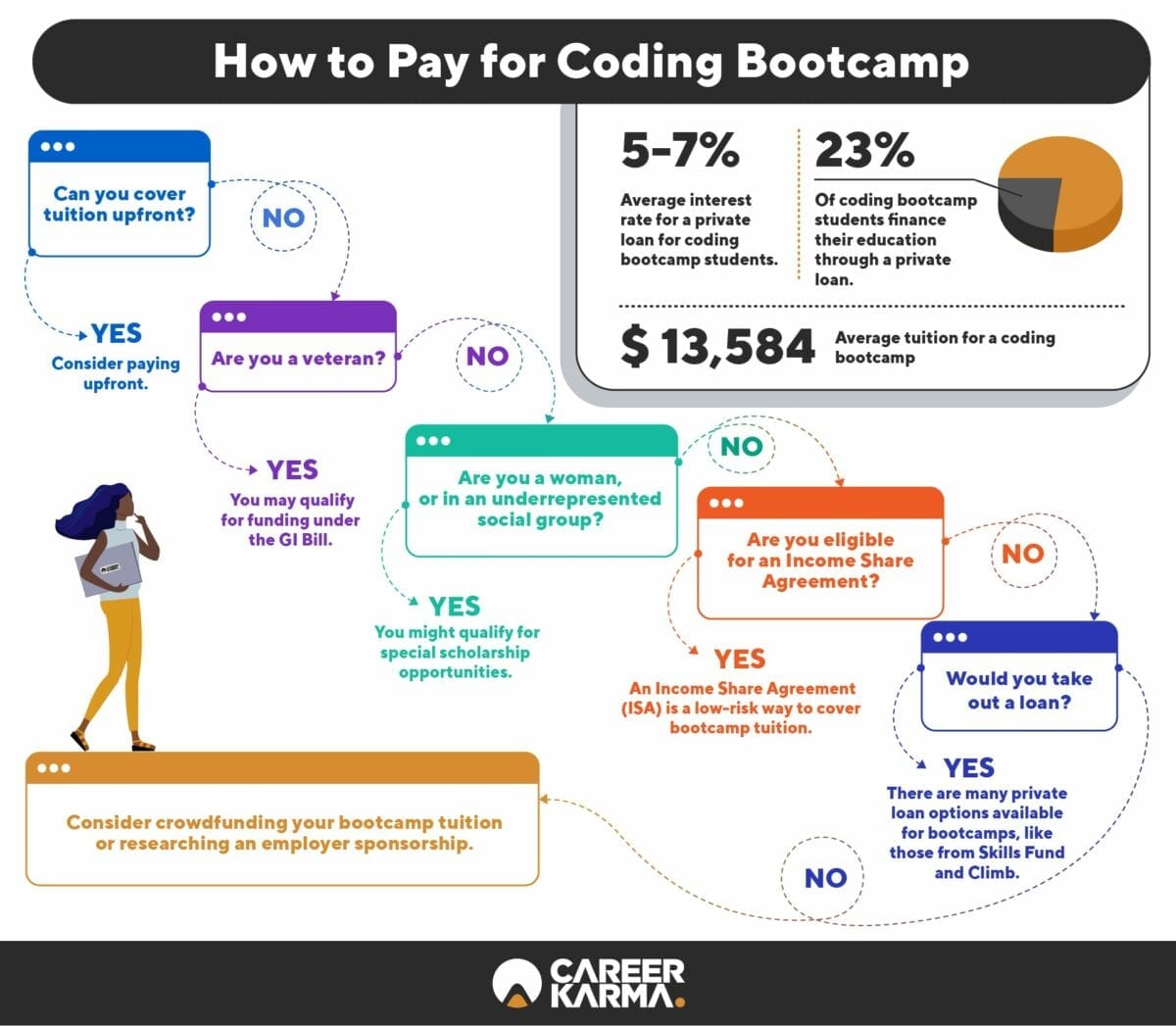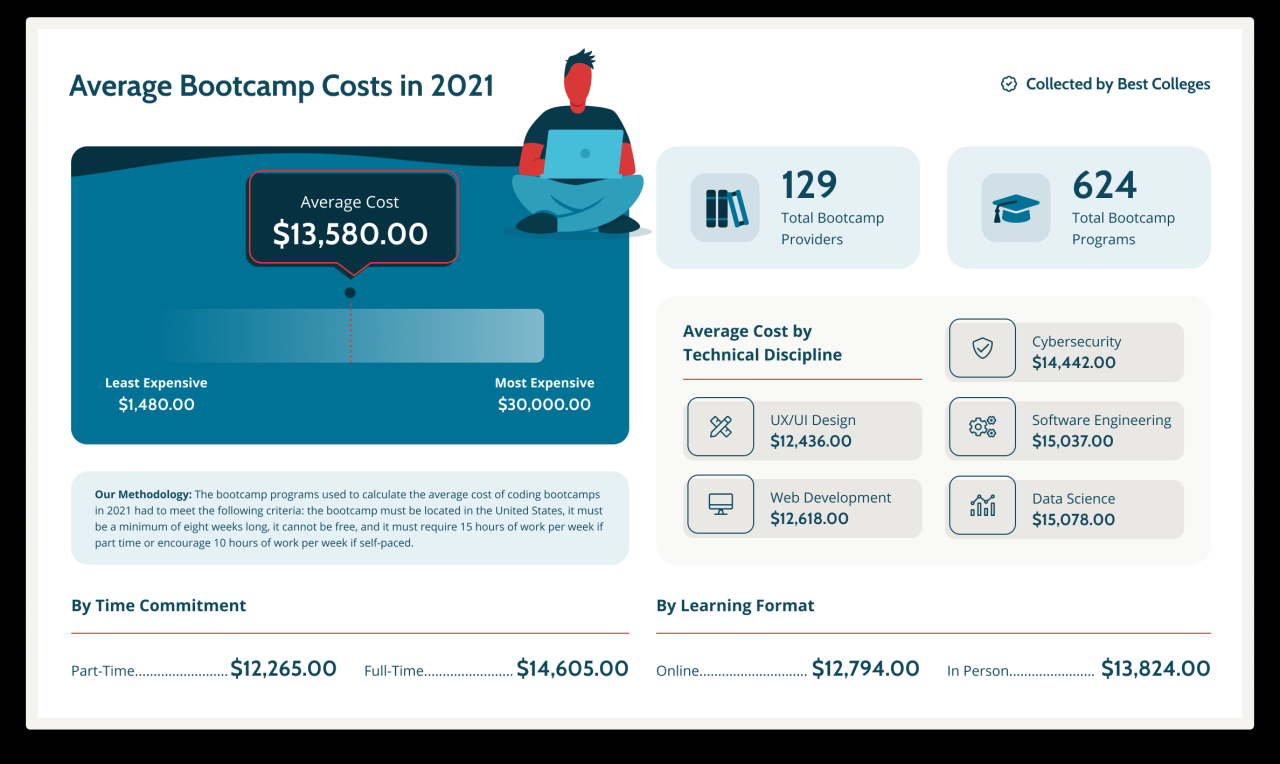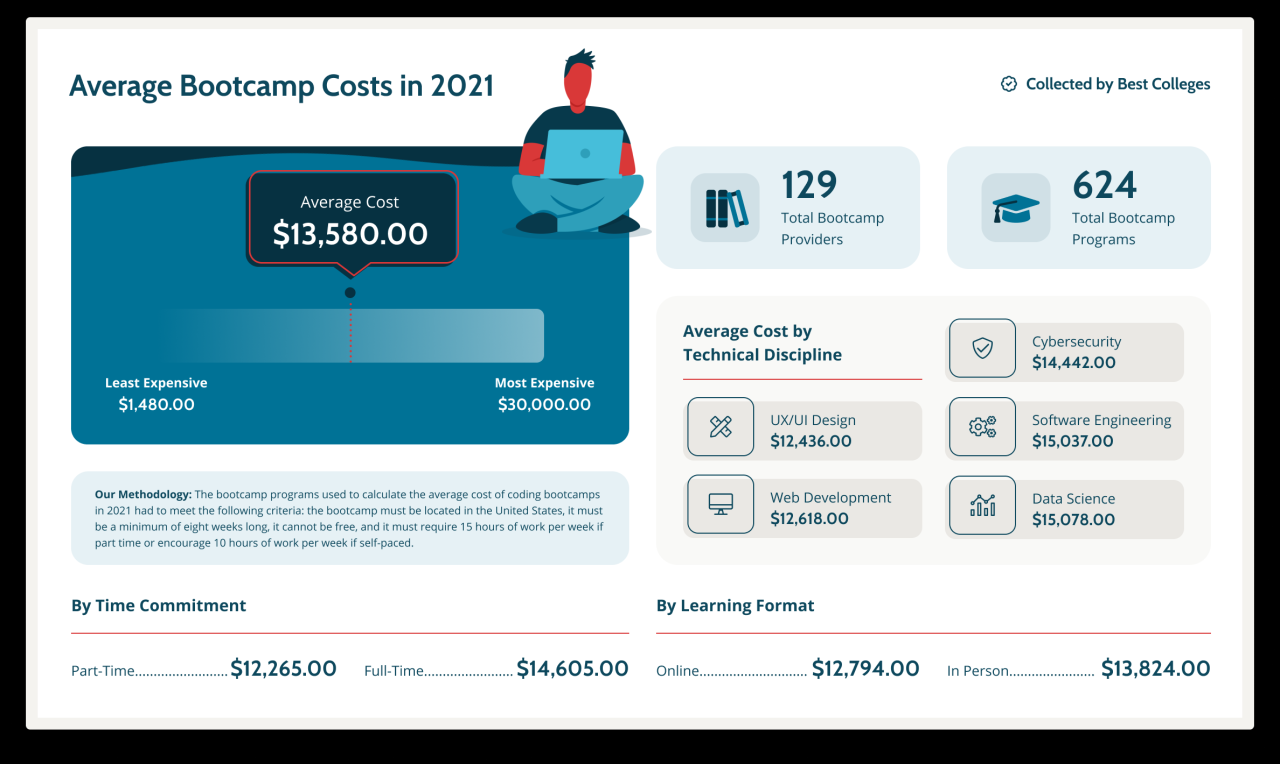Bootcamp Cost Factors

The price of a coding bootcamp is influenced by a variety of factors, making it crucial for prospective students to understand these elements before committing to a program. A thorough understanding of these factors allows for a more informed decision, ensuring the chosen bootcamp aligns with both educational goals and financial capabilities.
Several key factors significantly impact the overall cost of a coding bootcamp. These include the program’s length, the intensity of instruction (full-time versus part-time), the curriculum’s specialization, the reputation and location of the institution, and the inclusion of career services. Understanding the interplay of these factors is key to making a financially responsible choice.
Tuition Fees Across Bootcamp Types, How much is a coding bootcamp
Coding bootcamps offer varying program structures, each impacting the overall cost. Full-time bootcamps, characterized by intensive, immersive learning experiences, typically command higher tuition fees due to their condensed timeframe and concentrated instruction. These programs often require a significant time commitment from students, leading to a faster return on investment (ROI) but also a higher upfront cost. Part-time bootcamps, designed for working professionals or individuals with other commitments, generally have lower tuition fees spread over a longer duration. Online bootcamps present a cost-effective alternative, often featuring lower tuition than their in-person counterparts, although this can vary significantly depending on the program and institution. The flexibility of online learning, however, can sometimes lead to a longer program duration.
Impact of Location on Bootcamp Costs
Geographical location significantly influences bootcamp costs. Bootcamps in major metropolitan areas like New York City, San Francisco, and Boston typically charge higher tuition fees due to higher operating costs, including rent, instructor salaries, and overall market demand. These cities often attract top talent and offer higher earning potential for graduates, which is reflected in the program costs. Conversely, bootcamps in smaller cities or less populated areas may have lower tuition fees, but might also offer fewer career opportunities post-graduation. The trade-off between tuition cost and post-graduation job market should be carefully considered.
Bootcamp Cost Comparison Across US Cities
The following table illustrates a comparison of average bootcamp costs across three major US cities. These figures represent averages and can vary significantly based on the specific program, institution, and duration. It is crucial to research individual bootcamps for accurate pricing information.
| City | Average Tuition | Duration (Weeks) | Program Type |
|---|---|---|---|
| New York City | $15,000 – $20,000 | 12-16 | Full-time, Part-time, Online |
| San Francisco | $16,000 – $22,000 | 10-14 | Full-time, Part-time |
| Austin, TX | $12,000 – $18,000 | 12-18 | Full-time, Online |
Value Proposition vs. Cost: How Much Is A Coding Bootcamp

The decision to invest in a coding bootcamp is a significant one, requiring careful consideration of both the financial outlay and the potential return. While the upfront cost can seem substantial, it’s crucial to weigh this against the potential for rapid career advancement and increased earning potential compared to other educational paths. This section analyzes the return on investment (ROI) of a coding bootcamp and explores the value proposition it offers.
How much is a coding bootcamp – A coding bootcamp’s value proposition lies in its intensive, focused curriculum designed to equip students with in-demand tech skills quickly. This contrasts with traditional four-year computer science degrees, which often cover broader theoretical concepts and take significantly longer to complete. The accelerated nature of bootcamps allows for faster entry into the workforce, leading to a quicker return on the investment made.
Return on Investment Compared to Other Educational Paths
Comparing the ROI of a coding bootcamp to a four-year university degree requires considering several factors. The total cost of a four-year degree, including tuition, fees, and living expenses, is typically far higher than a bootcamp’s cost. While a university degree may offer broader knowledge, a bootcamp provides specialized skills directly applicable to current job market demands, often leading to quicker employment and higher starting salaries.
Alternatively, self-teaching through online resources is a less expensive option but often lacks the structured learning environment, mentorship, and networking opportunities provided by a bootcamp. This can significantly impact the speed and effectiveness of skill acquisition, potentially delaying entry into a well-paying tech role.
Examples of Successful Career Transitions
Many individuals have successfully transitioned careers after completing a coding bootcamp. For example, a former teacher might retrain as a front-end web developer, leveraging their existing communication skills and adopting new technical expertise. Similarly, someone with a background in finance could transition into a data analyst role, utilizing their analytical abilities and newly acquired programming skills. These transitions often result in substantial salary increases and greater career satisfaction.
Potential Salary Increase After Bootcamp Completion
The potential salary increase after a bootcamp program varies depending on factors such as the specific bootcamp, the student’s prior experience, and the job market. However, many bootcamp graduates report significant salary increases. For instance, a graduate might transition from a low-paying role to a junior developer position with a 50% or even 100% salary increase. This rapid increase in earning potential significantly contributes to a positive ROI.
Estimated ROI of Coding Bootcamps
The following table presents estimated average costs, starting salaries, and ROI for different types of coding bootcamps. Note that these are averages and actual results can vary widely. The ROI is calculated based on the difference between the average starting salary and the bootcamp cost, assuming a certain number of years to recoup the investment. This calculation simplifies the complex reality of career progression and salary growth.
| Bootcamp Type | Average Cost | Average Starting Salary | Estimated ROI (Years to Recoup) |
|---|---|---|---|
| Full-Stack Web Development | $15,000 | $70,000 | ~0.2 (Less than a year) |
| Data Science | $18,000 | $85,000 | ~0.2 (Less than a year) |
| Cybersecurity | $16,000 | $75,000 | ~0.2 (Less than a year) |
Hidden Costs

Beyond the advertised tuition fees, several hidden costs can significantly impact the overall expense of attending a coding bootcamp. Failing to account for these additional expenses can lead to unexpected financial strain and potentially jeopardize your learning experience. Careful budgeting and proactive planning are essential to mitigate these risks.
While the upfront tuition is a major expense, it’s crucial to remember that this is only a portion of the total investment. Many additional costs can accumulate quickly, potentially exceeding the initial tuition cost. Understanding these hidden expenses allows for better financial planning and a more realistic assessment of the bootcamp’s true cost.
Software and Technology Costs
Software licenses, subscriptions, and the purchase or upgrade of personal computing equipment can represent a considerable hidden cost. Many bootcamps utilize specific software applications (like IDEs, databases, and design tools) that students are expected to have access to. These licenses can range from a few hundred to over a thousand dollars depending on the specific tools required by the curriculum. Additionally, students might need to purchase or upgrade their laptops to meet the bootcamp’s technical specifications, which can involve significant expenditure. For example, a student might need to invest in a new laptop with sufficient processing power and RAM to handle demanding coding tasks, costing anywhere from $800 to $2000. Further, subscriptions to cloud services for collaborative coding or hosting projects can also add up over the course of the program.
Books and Learning Materials
While some bootcamps provide digital learning materials, many require the purchase of supplementary textbooks, workbooks, or online course materials. These additional learning resources can quickly accumulate, adding several hundred dollars to the total cost. The price of these materials can vary depending on the bootcamp and the specific courses taken. For example, a student might need to purchase several programming textbooks, each costing between $50 and $100.
Living Expenses
For students who relocate to attend a bootcamp, living expenses become a significant hidden cost. Accommodation, food, transportation, and utilities can quickly add up, especially in expensive metropolitan areas. Consider that a student relocating to a major city like San Francisco or New York City could easily spend $2,000 to $4,000 per month on rent alone, not including food, transportation, and other living expenses. This needs to be carefully factored into the overall budget.
Career Transition Services and Job Placement Assistance
Many bootcamps advertise robust career services and job placement assistance as part of their value proposition. However, the level of support and the effectiveness of these services can vary widely. While some bootcamps offer comprehensive support including resume reviews, mock interviews, and networking opportunities, others offer limited assistance. While this is often included in the tuition, the actual *value* derived from these services is variable and shouldn’t be assumed to guarantee employment. It’s important to carefully investigate the quality and extent of these services before enrolling.
Unexpected Expenses
It’s crucial to budget for unexpected expenses that might arise during the bootcamp. These could include:
- Unexpected medical expenses
- Emergency travel costs
- Replacement of damaged equipment
- Unexpected personal emergencies
- Costs associated with attending networking events
Building a buffer into your budget to cover these unforeseen circumstances is advisable. A contingency fund of at least 10-20% of your total estimated costs is a good starting point.


Tim Redaksi